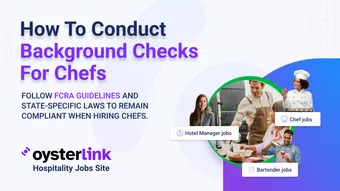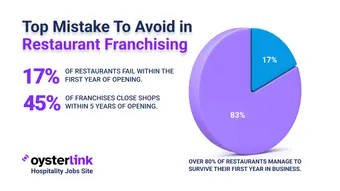If you're working in the restaurant industry — whether as a business owner or an employee — it's important to understand the Server vs. Waiter/Waitress distinction.
These terms are often used interchangeably, which can sometimes cause confusion about the specific responsibilities of each role. Although they share similarities, it's important to note that their meanings aren't entirely the same.
To clear things up, let's define both roles and break down the differences in job duties, required skills, dress codes, earning potential and more. We’ll also explore whether one title holds more prestige than the other and how the terms vary across different types of restaurants.
Server vs. Waiter/Waitress: What Are the Differences?
The lines between Servers and Waiters/Waitresses are a bit blurred and you'll often hear people use these terms in different ways.
Sometimes, the only difference between them is the gender of the term. "Server" is used as a gender-neutral term for the role, while "Waiter" is paired with "Waitress". Still, this is only the case in some states and individual establishments as these two roles aren't entirely the same.
More commonly, they have slightly different responsibilities and are viewed as two different job positions. To better understand what each of them involves, let's define both roles.
What Is a Server?
A Server is an employee, most commonly in a restaurant, who assists customers and co-workers. The role involves more than just taking orders and delivering food and drinks to tables. It also often sees them coordinating with kitchen staff, managing reservations and processing payments.
Like everyone else in the hospitality industry, they have to be polite and ensure customers have a pleasant experience at the establishment. They typically interact with customers when they're serving them food and drinks.
They should have detailed knowledge of the restaurant's menu and be ready to provide additional information about the dishes. If the customer is struggling to decide when making an order, they should be able to recommend a dish based on their liking.
What Is a Waiter/Waitress?
While there are different types of Waiters/Waitresses, they're typically employed in restaurants. They have a more focused set of responsibilities compared to Servers, which include taking orders from guests, bringing them food and doing everything else to ensure customer satisfaction.
The role of a Waiter/Waitress involves offering a more personalized service and interacting with customers throughout their entire stay at the establishment. A Waiter/Waitress also addresses any specific requests customers may have and checks if they need refills or want to order again.
Like Servers, they should be knowledgeable about the restaurant's menu and be able to help customers with their choices or recommend a dish.
Comparing Servers and Waiters/Waitresses
Many establishments using these terms in a similar way and understanding what exactly each role involves isn't always easy. To further clarify the Server vs. Waiter/Waitress distinction, let's look at some key similarities and differences between them.
With both Servers and Waiters/Waitresses taking orders and interacting with customers, some aspects of their work are similar. We listed the main ones in the table below:
While some aspects of their work overlap, these two roles aren't the same by definition, and there are some things that set them apart. To better understand this, let's look at some of the key differences between them:
Again, these differences aren't set in stone and what each role encompasses may vary by establishment. However, this should help you differentiate between the two terms and better understand what they typically entail.
Differences in Duties Between Servers and Waiters/Waitresses
To paint a better picture of the Server vs. Waiter/Waitress distinction, let's look at some of the key differences between these two roles more closely:
Scope of work
One of the key differences between these two roles is their scope of work.
The role of a Server involves more general work, such as managing information, clearing tables and adhering to sanitation and safety regulations. A Waiter/Waitress, on the other hand, pays more attention to individual tables and offers more personalized service.
A Waiter/Waitress pays closer attention to the details of each order and continues to assist customers throughout their entire stay at the restaurant. This includes offering refills, taking additional orders and more.
Additionally, a Server typically oversees large parts of the restaurant while a Waiter/Waitress focuses on assisting individual customers.
However, since not all establishments clearly define the line between a Server and a Waiter/Waitress, their scopes of work often intertwine.
Work environment
Not all restaurants employ both Servers and Waiters/Waitresses. More traditional restaurants only have one role which combines the responsibilities of both. Whether they refer to individuals in this role as Servers or Waiters/Waitresses is up to the establishment.
Upscale restaurants may, however, have both Servers and Waiters/Waitresses as part of their staff. In such an environment, their duties can be split. Servers will focus more on managing reservations and coordinating with the kitchen while Waiters/Waitresses will concentrate on delivering food and drinks.

Dress code
Similar to the work environment, the dress code for Servers and Waiters/Waitresses varies depending on the type of establishment.
In upscale or fine dining restaurants, employers expect Servers and Waiters/Waitresses to have a more polished look. That said, Fine Dining Servers typically wear more formal attire that follows a strict dress code, while the Waiter/Waitress uniforms focus more on combining elegance and functionality.
Meanwhile, in casual and mid-range restaurants, both roles may wear simple uniforms, such as polo shirts with aprons. Such types of places tend to have more relaxed dress codes, with the specific attire varying by establishment. Some restaurants provide branded uniforms, while others require standard black attire.
Regardless of the setting, both roles should prioritize cleanliness, proper grooming and comfortable footwear to handle long shifts efficiently.
Work requirements
Since restaurants often don't take into account the Server vs. Waiter/Waitress distinction, work requirements for both roles are usually the same. However, upscale restaurants may look for different qualities when hiring individuals in both roles.
When this is the case, you'll often see these establishments including organizational skills in the job description for Servers. This helps them bring in candidates who can offer exceptional service when managing reservations and coordinating with the rest of the staff.
For Waiters/Waitresses they may focus more on customer service due to the personalized nature of the role. Therefore, you'll often see the job description for Waiters/Waitresses include requirements such as friendliness and communication skills.
However, being a good Waiter/Waitress and Server is all about ensuring that customers have a pleasant time during their stay at the restaurant. Although Waiters/Waitresses interact with customers more often, individuals in both roles should know how to create a positive atmosphere and keep customers happy at all times.
How Servers and Waitstaff Can Deal With Challenging Customers Effectively
Encountering difficult customers is something to be expected in any restaurant job, but how you respond can make all the difference. Whether you’re a Server or a Waiter/Waitress, handling tense situations with diplomacy and professionalism helps maintain a positive dining experience for everyone.
By practicing patience, professionalism and good manners, you can turn difficult situations into opportunities to showcase excellent customer service. Below are a few tips to keep in mind.
1. Stay Calm and Listen Actively
When a customer is upset, your first instinct might be to defend yourself or the restaurant, but the best approach is to listen patiently. Let them express their concerns without interruption and acknowledge their frustration with a calm and understanding tone.
For more detailed strategies, check out our guide on handling difficult customers.
2. Use Polite and Professional Language
Good manners go a long way in diffusing tense situations. Always address customers respectfully — use “sir” or “ma’am” when appropriate, and avoid sounding defensive or dismissive.
Simple phrases like “I understand your frustration” or “Let me see what I can do to fix this” can make customers feel heard and valued.
3. Offer Solutions, Not Excuses
Rather than explaining why something went wrong, focus on what you can do to make it right. If a customer complains about a cold dish, offer to replace it immediately. If their order was incorrect, apologize sincerely and correct it as quickly as possible.
For more tips on resolving complaints effectively, visit our article on handling customer complaints in a restaurant.
4. Practice Emotional Awareness
Understanding and managing your emotions in high-pressure situations is crucial in hospitality. A difficult customer may not be angry at you personally, so don’t take their frustration to heart. Instead, focus on maintaining a professional attitude and responding with empathy.
Learn more about emotional control and customer interactions in our emotional intelligence tips for hospitality workers.
Compensation for a Server vs. a Waiter/Waitress
Understanding the earning potential for Servers and Waiters or Waitresses is essential for anyone considering a career in the restaurant industry. While both roles rely heavily on tips, their salaries can vary based on the type of restaurant, location and level of experience.
Base pay and hourly wages
In most restaurants, both Servers and Waiters/Waitresses receive a base hourly wage, with the exact pay rate differing depending on factors like the level of experience, geographic location and sometimes the establishment's menu prices.
Since these terms are often used interchangeably, salary data may not always distinguish between them accurately. However, recent figures show that Servers in the U.S. earn $17.05 per hour, while Waiters/Waitresses make $17.56 per hour. Moreover, Fine Dining Servers have a significantly higher average base wage at $27.20 per hour.
See also: What Restaurants Do Servers Make the Most Money At?
Tips and earning potential
Since both roles depend heavily on tips, income can fluctuate significantly based on the type of establishment, majority customer base and level of service provided.
Those working in casual dining establishments may earn an additional $50–$150 in tips per shift, depending on customer volume and tipping culture in the area.
Meanwhile, Fine Dining Servers generally make substantially more in tips, as they serve high-end clientele and handle larger check totals. In upscale restaurants, they can earn $200–$500 per shift in tips alone. This is because the tipping standard for such restaurants is often at least 16–18%, and anything below 15% is considered unacceptable.
Other financial benefits
Beyond base wages and tips, some restaurants offer additional financial benefits, including:
- Shift meals or meal discounts
- Health insurance (in corporate or high-end restaurants)
- 401(k) options (offered by some larger restaurant chains)
- Flexible schedules for supplemental income opportunities
Server vs. Waiter/Waitress Differences: Summary
As you've seen, the lines between the roles of a Server and Waiter/Waitress are blurred. Establishments often use both terms to describe the same role and differentiating between them isn't always easy.
The distinction is clearer in high-end restaurants that hire workers in both roles. In more traditional restaurants, these two roles are combined into one and are often referred to as either a Server or a Waiter/Waitress.
Both Servers and Waiters/Waitresses have the potential to earn competitive wages, but factors like restaurant type, location, and customer base significantly impact overall earnings.
If you're looking to start working in a restaurant, make sure you understand how that particular establishment defines both roles. That way, you'll have a better understanding of your role and preparing for it will be easier.
On the other hand, if you're an establishment owner or a hiring manager that's hiring workers for your restaurant, help potential applicants understand the difference by crafting job postings that are more accurate and concise.








Loading comments...